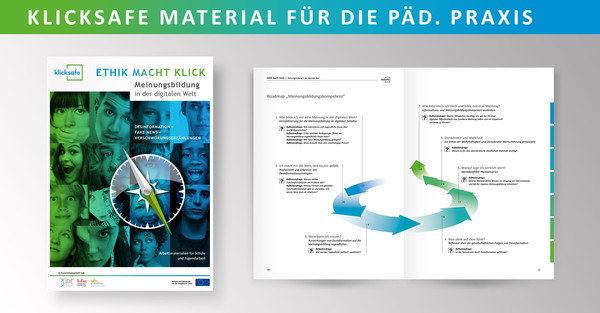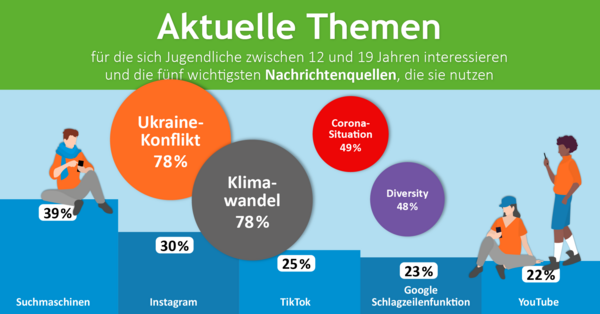Disinformation and opinion
The basis for a strong and vibrant democracy is an informed population. Unfortunately, access to information alone is not enough. News and content must be classified and their trustworthiness evaluated. From the trustworthy information, we must ultimately form our own opinions. Acquiring news literacy and opinion-forming skills is a lifelong learning process. Important foundations for these skills are laid in childhood and adolescence. In the following, we show how you can help young people evaluate information and form their own opinions.
The klicksafe handbook "Ethics makes click. Forming Opinions in the Digital World" provides insights into the information behavior of young people, offers assistance in analyzing and recognizing disinformation strategies, and shows the effects of misinformation on democratic society. The additional materials (copy templates, sound collage, word collection) can be downloaded by clicking on the image above.
How do young people inform themselves today?
In the 21st century, young people are growing up in a world in which they have easy and direct access to a wealth of information. Via their smartphones and social media such as YouTube, Facebook, Twitter and Instagram, they can not only receive information anytime and anywhere, but also evaluate and share it, or create messages themselves and enter directly into discourse with others.
When searching for information, a large proportion of 12- to 19-year-olds primarily use search engines (e.g., for Googling for terms). YouTube and online encyclopedias, such as Wikipedia, are also used to search for information.Journalistic services such as news portals of newspapers, magazines or TV stations are less relevant for young people.Only with increasing age do these offerings become more important as a source of information.
In social media, young Internet users tend to come into contact with news casually and by chance. They feel they are sufficiently informed about current events in Germany and the world.News in the traditional sense plays only a minor role in the everyday lives of young people.
In a digitized public sphere, the amount and range of information available have increased significantly. For young people, this diversity can also mean that they are unintentionally confronted with offerings that are extremist in nature, representconspiracy-theory positions or are part of state disinformation campaigns. There is competition between different players who influence the (political) opinion-forming of young people and compete for their attention. This makes it more complicated for young people to assess the truth of information.
Info from the net - is that a problem?
During adolescence, young people go through developmentalphases in which their personality and identity are formed. This also includes ideological positions and political opinions. The (political) socialization of young people now also takes place on the Internet and via social media.In addition to information and news offerings, communication via messenger services and exchanges in social networks also play a central role here.
Social media mix public and private communication. They create a new level of communication between traditional mass media and direct interaction. Young people's opinion formation is strongly oriented toward their social environment and peer group, with which they are also permanently connected online.
Bandwagon Heuristic
In social networks, in addition to the algorithms, friends and acquaintances are the gatekeepers to the information. If a user receives news via known social contacts, this tends to increase trust in the information. Most people consider statements and recommendations from their personal environment to be credible, whether in direct conversation or via social networks. This is particularly true if the disseminators are perceived as likeable and competent. This effect, that something that is considered good by others can also be considered good by oneself, is described as bandwagon heuristic. This effect can be used as a possible explanation for trust in incorrect information.
Insecurity through disinformation
Young people in particular, whose views of the world are still being formed, can be permanently influenced by manipulation strategies and disinformation. While young people with a higher level of education are generally able to deal with the offerings on the Internet in a reflective manner, young people with a lower level of education are particularly at risk. They can develop problematic world views that run counter to democratic basicideas. For example, a belief in secret elites who "pull the strings" in the background.The Shell Youth Study 2019 found that almost every second person in this group of young people is inclined toward populist positions. In addition to life-world reasons and the feeling of being disadvantaged, social media reinforce this tendency.
Confirmation Bias
Whether we believe something and consider it possible depends on what beliefs and ideas we have. New information that fits our beliefprinciples is integrated into our imagination and believed to be true. If we encounter information that does not fit our belief system, we experience mental stress. To compensate for the contradiction, we hold as credible only the information that reinforces our opinions, even if it should be false or used manipulatively. The more closed and simple a worldview is, the more likely the confirmation bias will have its effect.
Tips for parents and educational professionals
Young people are often on social networks and get information online. In doing so, they are not always able to correctly assess the credibility of information. They often lack the necessary prior knowledge to recognize contradictions. In addition, they tend to trust people they know even more than adults - even if only from the Internet.
However, to form an assured opinion, one needs facts and figures instead of manipulated images, videos or made-up headlines. That's why it's important that guardians also discussthe topic of disinformation with them in an age-appropriate way and make it clear that there are misleading messages on the Internet. Education helps to stop the spread of fake news.
It is important to teach children that they can also come across disinformation and false news in the colorful online world. It helps if you start talking to your child about this at a very early age and make it clear that not everything on the Internet is true. It should be made clear that there are people who deliberately spread false information (disinformation and/or conspiracy ideologies) in order to make money or influence opinions. A healthy distrust in dealing with information is therefore important. This is how your child learns to classify and question opinions and news.
- klicksafe quiz for young people on the subject of fake news and conspiracy theories
- Actionbound game from klicksafe for young people "In the bunker of lies".
- Info brochure for parents and educators:"Do you still trust or do you already check?"
- Family checklist on the topic of fake news
- SWR Fakefinder (from 14 years), SWR Fakefinder Kids (from 8 years)
- Learning module for children of primary school age on the Internet ABC
Discuss world events with children and young people and exchange different opinions and news sources. You can approach the topics through current debates, for example, on the corona pandemic. Especially in uncertain times, you are important discussion partners.
Because they look like trustworthy news, read excitingly and often shock, false reports spread at breakneck speed. Recognizing the difference between true and false at first glance and filtering information: Given the flood of information on the Internet, this is already difficult for adults. It's even harder for young people and children. The following points can help to unmask false news:
Take acritical look at sensational headlines: Does the headline shock? Is it surprising and does it provoke strong emotions such as fear or hatred? What seems directly implausible often is.
Be critical and check source: Where does the information come from? Can you find out who published or wrote the message? Are name and address given in the imprint? A look at the authorship or imprint of a website usually shows who is behind the content. Are they biased? Do they know their stuff? What are their intentions?
Check the facts: Is what is claimed true? Is the information really correct? Have other, trustworthy news sources published the same report? Beware of texts that are primarily reduced to the headline and also present a lot of opinion and little content. If the headline does not find any hits from other (reputable) media in the search engine, the report is probably fictitious. Special fact checkers such as Mimikama.at, CORRECTIV, ARD-Faktenfinder and Hoaxmap make research easier. Simply enter the search term there.
Pay attention to up-to-dateness: How up-to-date is the information? Particularly in the case of scientific studies, surveys or statistics, it is important to ensure that the information is not too outdated and possibly already obsolete. In search engines, a preset filter that restricts the time period of the results helps to find the latest information on a topic.
Take a closer look at an image or video: What can be seen? Where did the image or video come from? Does it look unbelievable, or was it taken out of context? Google on the computer is suitable for reverse image searches. On smartphones and tablets, for example, the TinEye app can help.
Become active: Report false reports on the platform or contact fact checkers.
Do not forward unchecked: Do not share news lightly, the rule here is: first check the facts and check the source - then forward.
Donot ignore: Respectfully point out to forwarders when they are spreading false news. They may not have known that the content comes from a dubious source.
Counter skillfully: For example, by posting funny memes. Or support other users who disagree with a Like. But be careful: Some topics can heat up the tempers in a discussion. Such arguments are not very effective.
Children can find good offers for age-appropriate information via children's search engines such as Blinde Kuh or fragFinn. For elementary school children, there are special news services such as ZDF logo! or Kruschel. Older children can be shown different, reputable news sites so that they can compare reports if they are unsure.
Fact checker services such as Mimikama.at, ARD-Faktenfinder or CORRECTIV help debunk fake news.



